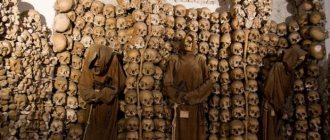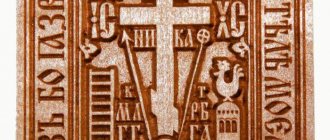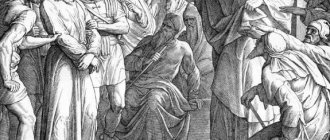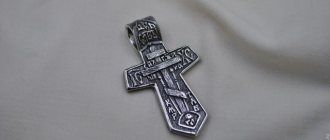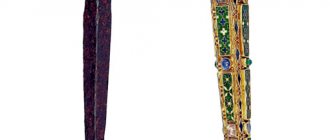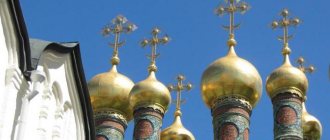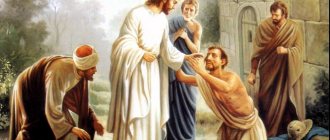Most people have heard about the crucifixion of Jesus. But have you ever wondered why Jesus died on the cross? The Bible tells us that His conduct was blameless in every way. His words were full of love, wisdom and truth. He cared for people of all kinds: strong and weak, rich and poor, young and old, moral and immoral, revered and despised. Why did Jesus, a truly extraordinary man, have to die such a terrible death on the cross?
Sin separated us from God.
When Satan, through his wiles, succeeded in deceiving Eve, who in turn persuaded Adam to disobedience, sin entered into human nature. Sin stood between people and God, like a curtain separating them from the source of life. In spiritual understanding, they became dead in their trespasses and sins. (Eph. 2:1) Sin entered the world, bringing with it a curse, and from that time on, all living things were doomed to physical death.
The sin that penetrated the nature of Adam and Eve was passed on to their descendants. This “sin in the flesh” is the tendency of our nature to do our own will instead of the will of God. If we follow this tendency when we are tempted, then we commit sin. To help people stay on the right path, God gave them His laws that described His will for them.
Unfortunately, the people were very weak; there was not a single one among them who could keep himself clean from sin. Even the best of them sinned daily in thought, word and deed. In other words, everyone was found guilty, and Satan could use this as a letter of indictment against them, demanding death for them. (Rom. 5:12) In the temple, symbolizing God's house on earth, in front of the Holy of Holies hung a large veil, symbolizing sin in the flesh, which separated people from God. Whoever passed through this veil immediately died, because no sin could dwell in the presence of God.
Secrets of the Aztecs and Leonardo da Vinci
Some pious noble houses of Europe donated family libraries to the Vatican. Many of them are so extensive that they are poorly understood. It is possible that they may contain valuable information about the historical processes of the dark era of the Middle Ages.
One of the most protected is the archive of Leonardo da Vinci's records. A number of his diaries have not been published anywhere and are unlikely to be made public in the future. Authorities fear that some information could undermine the authority of the church.
“It’s really expensive”: Vasilisa Volodina announced the cost of an hour of her consultation
A note for spicy food lovers: why mustard is harmful to health
They became beauty icons in Arab countries: the most popular bloggers of the East
There are also persistent rumors that the Vatican owns priceless “books” of pre-Columbian civilizations in America. You can believe this, because the conquistadors who conquered the Incas, Mayans, and Aztecs acted on behalf of not only the Spanish crown, but also the church.
The Vatican still has enormous influence in Latin America today. It is quite possible that he is in charge of the secret knowledge of ancient civilizations, including the mysterious Toltecs. Presumably, they contain information about contacts of ancient peoples with aliens.
Forgiveness through sacrifice.
God, in His long-suffering, gave people a chance, thanks to which, by sacrificing blameless animals, they could receive forgiveness. Once a year, the high priest could enter the Holy of Holies, offering the blood of sacrifices and obtain redemption for the people. Through the shedding of the blood of an innocent victim, the debt of sin was paid. (Lev. 17:11; Heb. 9:22)
However, the blood of animals could not eliminate the root of the problem - the sin living in human flesh. After their sins were forgiven, people continued to sin, meaning that they had to return and make new sacrifices, again and again, year after year. Even the high priest could not help them, because he himself was also a sinner. When making sacrifices, he made them for himself and for the sake of the people. (Heb. 10:1-4)
God hated it. He wanted to share fellowship with people and save them. He was looking for someone who could break this vicious circle of sin and forgiveness. Although there have been righteous and God-fearing people throughout history, none of them were blameless and could “stand in the gap” between God and people. Therefore, God sent His own Son to do the greatest work in human history. (Ezek. 22:30; Isaiah 41:28; Isaiah 60:16; Isaiah 63:5; John 3:16-17)
Jesus in a human being.
Jesus was the Son of God, but despite this He “poured out Himself” and became the “Son of man” - becoming a man in every sense of the word, coming in the same flesh as ours. This means that Jesus was tempted just like we are. However, He was born of the Spirit of God and this Spirit accompanied Him throughout His life, giving Him the strength to complete the task that was entrusted to Him. (Luke 1:30-35; Phil. 2:5-8; Isaiah 61:1-3)
“Being made in the likeness of men, and becoming in appearance like a man; He humbled himself, becoming obedient even to the point of death, even death on the cross.” Phil. 2:8. As a man, Jesus had to learn obedience because, like men, He had His own will and sin in His flesh, and He was tempted. He learned to deny Himself, “to take upon Himself His cross every day,” and to put to death sin. As a result, Jesus never sinned. (Heb. 2:18; Heb. 4:15; Heb. 5:7-8)
When Jesus spoke out against sin and against the hypocrisy of the religious leaders of his day, He spoke with conviction as one in authority. Since death over sin took place in His inner man, hidden from the eyes of men, almost none of His contemporaries could understand Him. So in the end He was arrested and crucified. A pure, righteous and blameless man died like a criminal who was punished for sins that he never committed. Why?
Evidence of the Empty Tomb of Jesus Christ
The presence of an empty tomb is proven by the fact that sermons about the resurrection of Christ in Jerusalem began a few weeks after the crucifixion. These sermons were held publicly, in front of thousands of people. We know this from the second chapter of the book of Acts. That the resurrection of Christ has been preached since the earliest days of the Christian movement is recognized even by the most ardent critics of Christianity.
If Christ's tomb had not been empty, then the resurrection would not have been preached. The body of Christ could be presented, and the Christian movement would cease to exist as quickly as it began. How the tomb of Christ ended up empty is another question, but the fact is that it was empty.
Redemption.
Being blameless and the only person in history who was not defiled by sin, Jesus was the only one who could “stand in the gap,” the only one on whom Satan had nothing. He was the only one who did not deserve death, neither physical nor spiritual. Despite this, He willingly sacrificed Himself to complete the task for which He came to earth. He was crucified as an immaculate sacrifice. He died as the Lamb of God for the redemption of all mankind. He bore the punishment for all our sins and the Righteous One died for the unjust. (Rom. 5:10; 2 Cor. 5:21; 1 Peter 3:18) He not only suffered physical death, but also experienced separation from God while hanging on the cross. (Matt. 27:46; Mark 15:34) Because of His sacrifice, all who believe in Him have the opportunity to receive forgiveness.
Although Jesus' death on Calvary was unquestionably one of the most significant events in human history on earth, it was only part of the history of Christianity. Through the power of the Holy Spirit, who was with Him from the moment of His birth, Jesus “suffered in the flesh,” rejecting it and not giving in to the sinful tendencies that lived in His human nature. Thus, sin in His flesh was judged and “suffered to death,” “crucified,” along with its lusts and desires. Even though Jesus was tempted, He never sinned. (Heb. 2:18; Heb. 4:16)
Dying on the cross, Jesus exclaimed: “It is finished!” At that moment, absolutely every remnant of sin inherited by His human nature was crucified, and His work on earth was completed. When Jesus died, the curtain of the temple was torn from top to bottom. The debt was paid. The path leading back to the Father was open.
Jesus' victory over sin was also a victory over death. He did not remain in the grave, but rose from the dead in a glorified body containing the fullness of the Divine nature. Forty days later He was taken up into heaven, where He sits today at the right hand of His Father. (Phil. 2:5-11; Col. 2:9)
Evidence of the Crucifixion and Death of Jesus Christ
There is very strong evidence for the crucifixion and death of Jesus on the cross. We have direct indications of this in all four Gospels - Matthew, Mark, Luke and John. There is no possibility that the Gospel writers invented the story of Christ's crucifixion. In addition, at least three non-Christian historians write about the crucifixion of Jesus Christ. One of them is Cornelius Tacitus, a Roman historian. He wrote his works at the very beginning of the second century. This is what he writes in his Annals:
And so Nero, in order to overcome rumors, found the guilty and subjected to the most sophisticated executions those who, with their abominations, had brought upon themselves universal hatred and whom the crowd called Christians. Christ, from whose name this name comes, was executed under Tiberius by the procurator Pontius Pilate; suppressed for a while, this harmful superstition began to break out again, and not only in Judea, where this destruction came from, but also in Rome, where everything that is most vile and shameful flocks from everywhere and where it finds adherents. (Annals, 15:44)
There is also a record from the Jewish historian Josephus, this is what he wrote in 94 AD:
“About this time lived Jesus, a wise man, if he can be called a man at all. He performed amazing deeds and became a teacher of those people who willingly accepted the truth. He attracted many Jews and Greeks to himself. That was Christ. At the insistence of our influential people, Pilate sentenced him to the cross. But those who loved him before did not stop doing so now. On the third day he appeared to them alive again, as the divinely inspired prophets had announced about him and his many other miracles. To this day there are still so-called Christians who call themselves, therefore, by his name.” (Antiquities of the Jews, 18.3.3)
But there is a slight problem with this passage from Antiquities of the Jews, because... there is evidence that some parts of this passage contain interpolation (later added material not contained in the original) from Christian sources. This is what the text most likely looked like originally in Josephus:
“Around this time lived Jesus, a wise man. He performed amazing deeds and became a teacher of those people who willingly accepted the truth. He attracted many Jews and Greeks to himself. At the insistence of our influential people, Pilate sentenced him to the cross. But those who loved him before did not stop doing so now. To this day there are still so-called Christians who call themselves, therefore, by his name.”
There is another non-Christian source about the crucifixion of Christ - the Babylonian Talmud (second half of the second century). This Talmud was written as a direct attack on Christianity, but it nevertheless makes reference to the crucifixion:
Brothers of Jesus!
How is Jesus' sacrifice different from the sacrifices and forgiveness of the Old Testament? How did Jesus' death on the cross take away sin from our flesh? Why are we still tempted? Because the forgiveness of sins itself was not the main goal of Jesus' life, and it is not the main goal of Christians. In fact, receiving forgiveness is just the beginning. Jesus Himself speaks very clearly about this: “If anyone wants to come after Me, let him deny himself, and take up his cross, and follow Me.” Luke 9:23.
Jesus' goal was not only to become an atonement sacrifice for the sins of the people. He wanted to get disciples, those who would follow Him. We cannot follow Him in His physical death on the cross of Calvary, but we can take our cross upon ourselves every day!
By following Him along this path, we become His disciples. He sends us the Holy Spirit so that we may receive the power with which He overcomes sin. We also suffer in the flesh, we also crucify the flesh with passions and lusts and put to death the “deeds of the body” by the Spirit, and we are also freed from sin, become “members of His body,” we become brothers of Jesus, and we become participants in the Divine nature ! (1 Peter 4:1-2; Gal. 5:24; Rom. 8:13; 1 Cor. 12:12-14; Heb. 2:11; 2 Peter 1:2-4)
The death of Jesus on the cross of Calvary was the culmination of His incredible feat of love performed for us - people. By His death, Jesus reconciled those who believed in Him to God, and by His life, He opened for those who follow Him the path leading back to the Father. By dying over sin, Jesus conquered death. (Heb. 2:14-15) By His life He gave us life. May His sacrifice not be in vain, yes, may He have many disciples whom He will not be ashamed to call His brothers!
PAID IN FULL!
Third,
In the world, the word
tetelestai
was used in the field of entrepreneurship to determine
the full repayment of debt.
When the debt was fully repaid, the document in which the debt was recorded was stamped with the word
tetelestai.
This meant that the debt
fully paid.
Thus, when a person calls Jesus Lord of his life and personally accepts His sacrifice, he is completely forgiven the debt of his sin.
The debt is completely canceled because Jesus paid a price for it that no sinner
could
ever Jesus took our place. He paid the debt of our sin. And when we repent and accept Him as our Lord by faith, we become completely free!
This is why Paul wrote:
“In whom we have redemption through His blood, and the forgiveness of sins” (Colossians 1:14).
When Jesus said, “It is finished!”
– it was a proclamation that our debt was
completely cleared, paid and closed.
His blood
cleansed us all once and for all This applies to everyone without exception who has believed in Christ.
